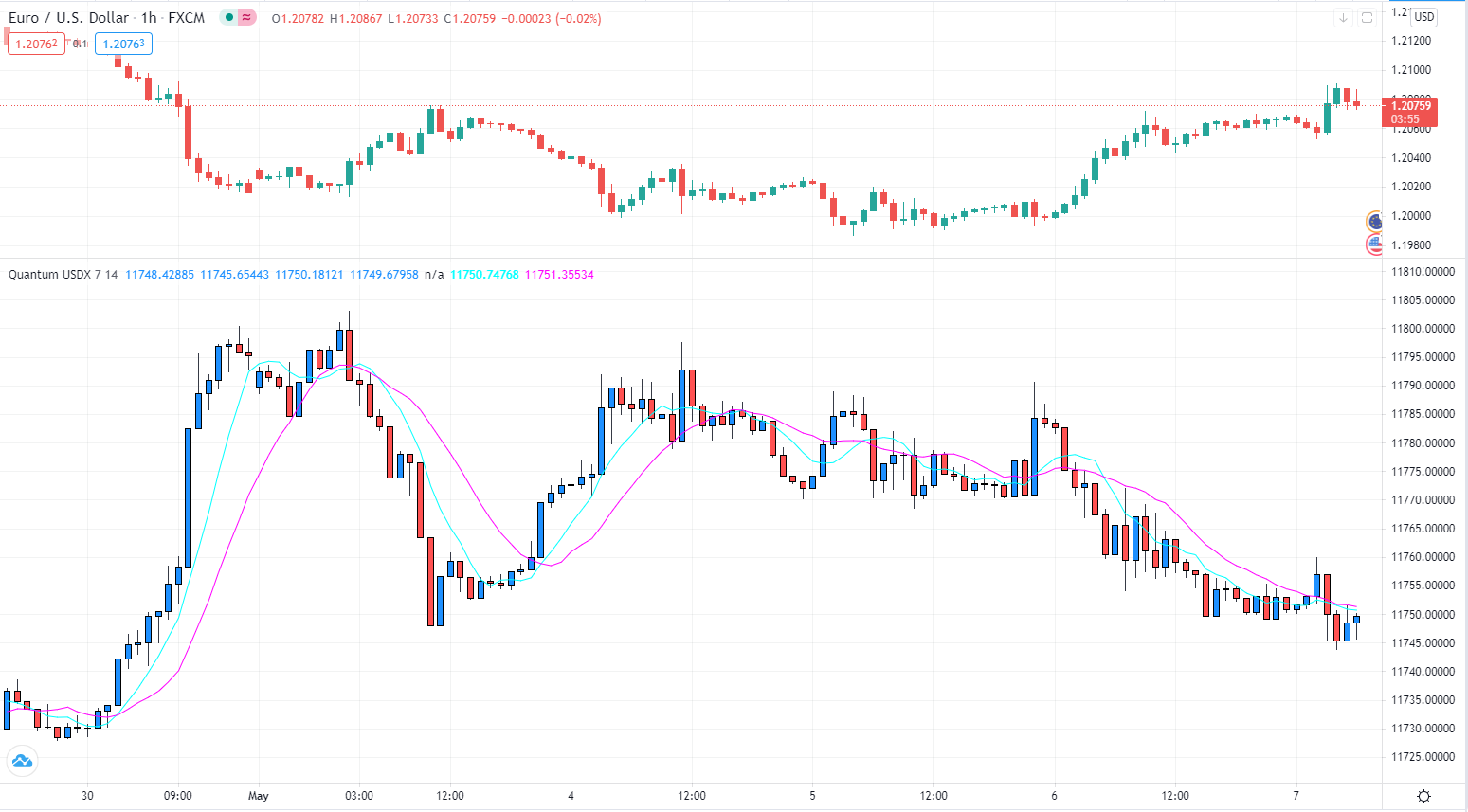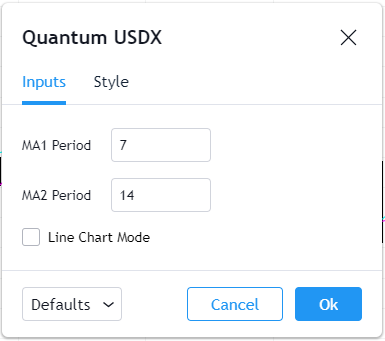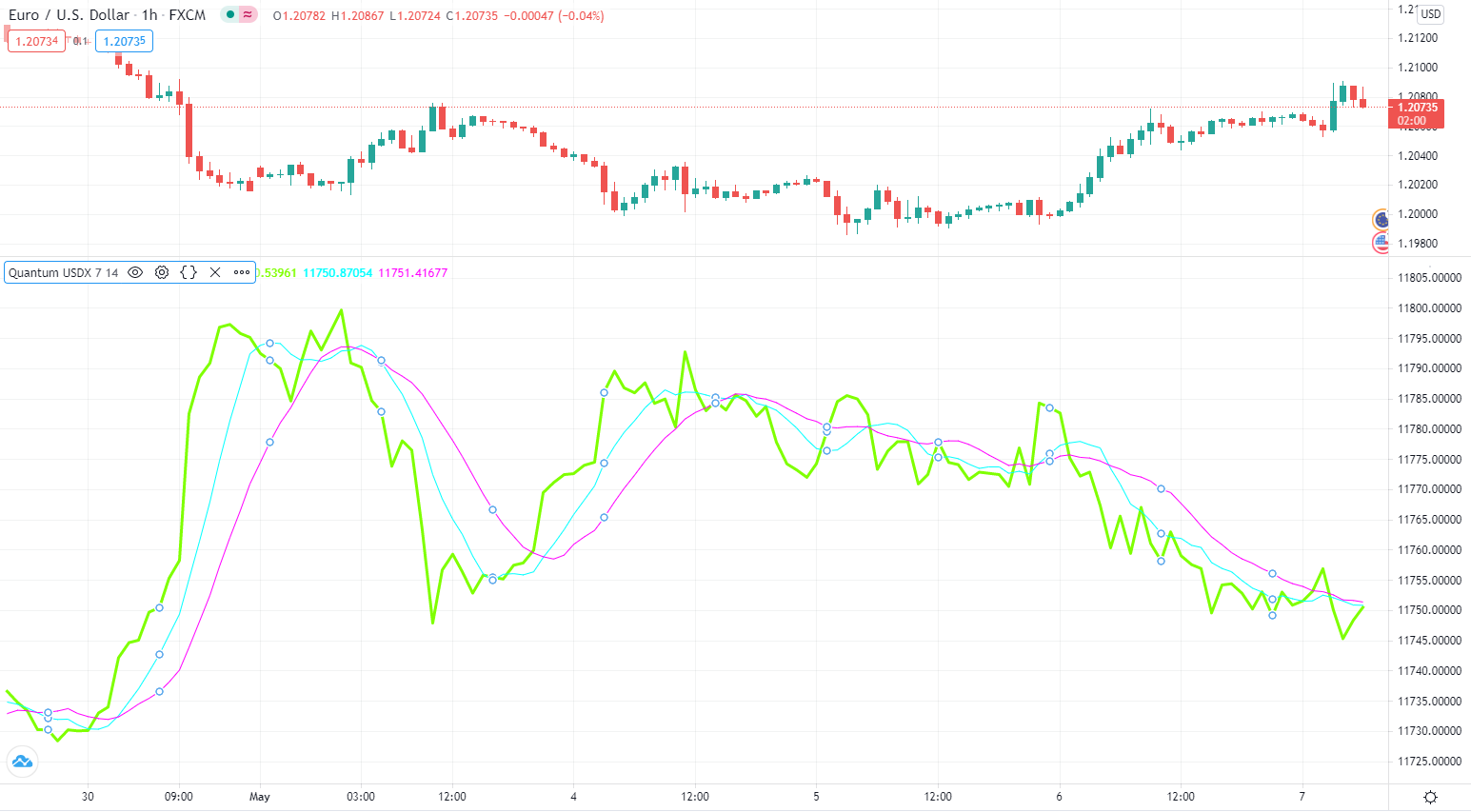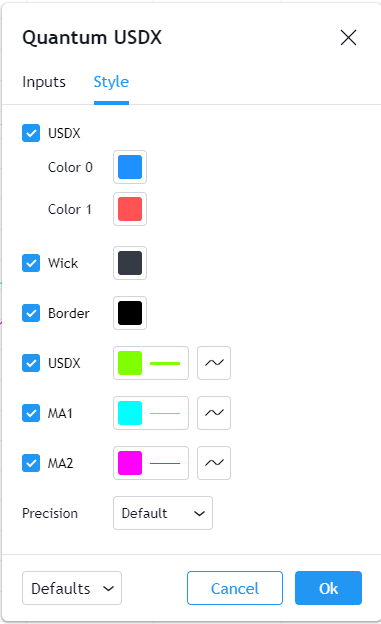Overview

At Quantum Trading, we like to give you a choice, and to offer what we believe are the ‘best of breed’ alternatives to those indicators many traders use. And this is another example. Many forex traders rely on the traditional (March 1973) DXY indicator to signal strength and weakness in the US dollar, and this works perfectly well. It is an index that has been around for over 30 years. However, times change, and none more so than in the forex market in the last five years. The US dollar still accounts for over 87% of currency transactions, but the significance of other currencies is growing fast, and the general view is the DXY is perhaps not so relevant as it once was, given the constituents of the underlying basket of currencies. Perhaps the three most glaring anomalies are the heavy weighting of the European currencies, the exclusion of the Australian dollar, and the minor weighting of the Japanese yen.
Whilst there are new indices being developed all the time, and indeed Bloomberg have recently launched the BBDXY as an alternative, we believe simplicity is the key, and have therefore developed the USDX index for the TradingView platform. This is based on the FXCM/Dow Jones index, and takes four major currencies, with an equal weighting to deliver the USDX index as follows:
- Japanese yen (JPY) – 25%
- Australian dollar (AUD) – 25%
- Euro (EUR) – 25%
- British pound (GBP) – 25%
The index is based on a notional 10,000 mini lot contract size and unlike the DXY is therefore quoted to five figures and two decimal places. It is our belief this simple index provides a ‘real world’ view of strength and weakness in the US dollar, with a more representative sample of world currencies. But why not try both – and see which you prefer.
The Quantum USDX indicator can be used in one of three ways:
- First, as an inverse indicator of a major currency pair, helping you get in, stay in and get out
- Second, as a confirming indicator for the Quantum Currency Strength indicator, providing a perspective against other currencies
- Finally, as the ultimate barometer of risk
Whichever approach you adopt, you will no longer have to leave your TradingView platform for a view of the US dollar.
The Quantum USDX indicator works in all timeframes.
Settings

The Settings button appears as a small cog/gear icon beside the name of the indicator at the chart. Clicking the button shows a dialog box for configuring the Inputs and Style options.
Inputs

MA1 Period
This is the period of one of the 2 simple moving averages which are part of the USDX indicator. It is set to 7 by default. Though this is the faster moving average of the two, you are free to set this to any other timeframe to suit your personal preferences.
MA2 Period
This is the period of the second simple moving average for the USDX. It is set to 14 by default. Though this is the slower moving average, you are free to set this to any other time frame of your choice.
Line Chart Mode

The Quantum USDX indicator uses a candlestick plot by default, but if this property is enabled, it will use a line plot to display the index.
Style

USDX (candlestick)
This forms the body (open and close price) of the index’s candlesticks.
- You can hide or display all candlesticks (when Line Chart Mode is disabled) in the index using the checkbox.
- You can customize the color and opacity of the bullish and bearish candlesticks by clicking the color boxes. Color 0 is the color of bullish candlesticks which is blue while Color 1 is the color of bearish candlesticks which is red.
Wick
This forms the shadow (high and low price) of the index’s candlesticks.
- You can hide or display the wicks of the candlesticks in the index using the checkbox.
- You can customize the color and opacity of the wicks by clicking the color boxes.
Border
This is a thin line that wraps the body of the index’s candlesticks.
- You can hide or display the border of the candlesticks in the index using the checkbox.
- You can customize the color and opacity of the border by clicking the color boxes.
USDX (line)
This line plots the index when the indicator is in Line Chart Mode.
- You can hide or display the USDX line (when Line Chart Mode is enabled) using the checkbox.
- You can customize the color, opacity, and thickness of this plot by clicking the color box. The default color is green, and the thickness is set to 3.
- The second box allows you to change the plot type and enable the Price Line. The Price Line is a horizontal line that keeps track of the plot’s current value. Changing the plot type is not recommended.
MA1
This line plots the first simple moving average on the indicator.
- You can hide or display the MA1 line using the checkbox.
- You can customize the color, opacity, and thickness of this plot by clicking the color box. The default color is cyan, and the thickness is set to 1.
- The second box allows you to change the plot type and enable the Price Line. The Price Line is a horizontal line that keeps track of the plot’s current value. Changing the plot type is not recommended.
MA2
This line plots the second simple moving average on the indicator.
- You can hide or display the MA2 line using the checkbox.
- You can customize the color, opacity, and thickness of this plot by clicking the color box. The default color is magenta, and the thickness is set to 1.
- The second box allows you to change the plot type and enable the Price Line. The Price Line is a horizontal line that keeps track of the plot’s current value. Changing the plot type is not recommended.
Precision
This determines the number of decimal places the indicator uses to display the current value of its plots. You can adjust this by choosing from a drop-down list.
Alerts
The USDX indicator has 1 alert condition.
MA Crosses
Alert Conditions
- USDX MA Cross
Condition
Triggers when the 2 moving average plots of the indicator cross each other
Alert message
Example:
- USDX moving averages crossed at MA1 = {value of first MA} | MA2 = {value of second MA}
